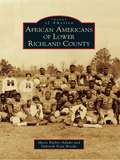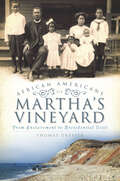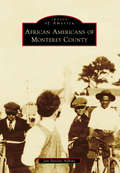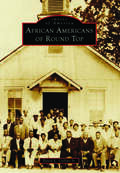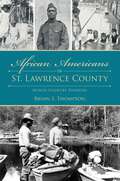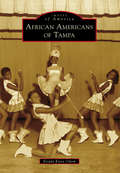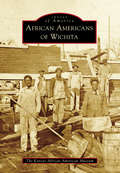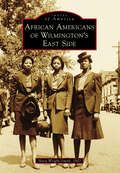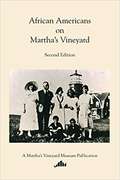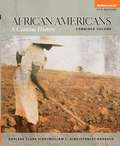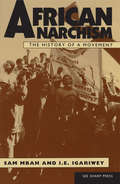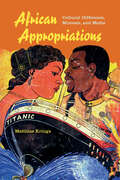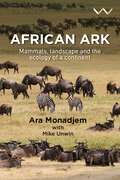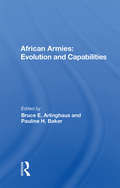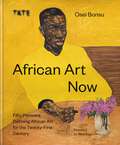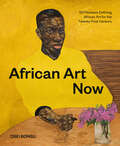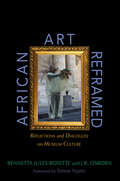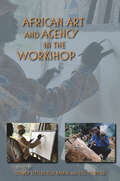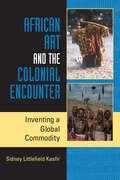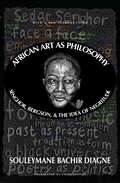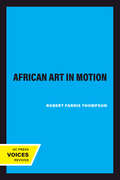- Table View
- List View
African Americans of Lower Richland County (Images of America)
by Deborah Scott Brooks Marie Barber AdamsLower Richland County encompasses approximately 360 square miles in the heart of South Carolina's geographic center. The Wateree River cradles it to the east, and the Congaree River borders the south and southwest. Virginia settlers discovered this rich land over 250 years ago. They became wealthy planters and accumulated large land tracts, creating plantation systems that sustained the economy. From 1783 until 1820, cotton was the principal cash crop, and the slave population increased tremendously and played a vital role in the development of agriculture and the economy in the area.
African Americans of Martha's Vineyard: From Enslavement to Presidential Visit (American Heritage)
by Thomas DresserAfrican Americans of Martha's Vineyard have an epic history. From the days when slaves toiled away in the fresh New England air, through abolition and Reconstruction and continuing into recent years, African Americans have fought arduously to preserve a vibrant culture here. Discover how the Vineyard became a sanctuary for slaves during the Civil War and how many blacks first came to the island as indentured servants. Read tales of the Shearer Cottage, a popular vacation destination for prominent blacks from Harry T. Burleigh to Scott Joplin, and how Martin Luther King Jr. vacationed here as well. Venture through the Vineyard with local tour guide Thomas Dresser and learn about people such as Harvard professor Henry Louis Gates and President Barack Obama, who return to the Vineyard for respite from a demanding world.
African Americans of Monterey County (Images of America)
by Jan Batiste AdkinsPeople of African heritage have traveled to Monterey since the 1770s, when African Spaniard Alexo Nino, a ship's caulker, traveled with Fr. Junipero Serra to Monterey via the San Antonio. For centuries since Nino, black men and women migrated to the Monterey Bay area in search of a new life. In the 20th century, some African Americans established businesses, bought homes, and encouraged family members and friends to settle in Monterey County. Others pursued military careers. Out of these communities came churches, schools, service organizations, and social groups. For the next century, the history of Monterey County's African American communities have mirrored the nation's slow progress toward integration with triumphs and setbacks that have been captured in images of employment opportunities, churches, business successes, and political struggles.
African Americans of New Orleans (Images of America)
by Phoenix Savage Turry FluckerEnslaved Africans and free people of color of Louisiana deserve the title of "Founding Fathers" just as much as the French, the Spanish, and the Americans. In spite of their subjugated role as slaves, African Americans of Louisiana, and subsequently New Orleans, were contributors to the success of the state and the city far beyond their role within the labor force. Imported into the Louisiana Territory by John Law's Company of the Indies, enslaved Africans, fed on a pound of corn a day, gave birth to American figures of the 19th and 20th centuries. Mahalia Jackson, Louis Armstrong, Homer Plessy, Marie Laveau, Buddy Bolden, Julies Lion, Alice Dunbar-Nelson, the fighting men of the Louisiana Native Guard, Ernest "Dutch" Morial, and many other African Americans contributed to the growth and development of New Orleans. Every African American citizen of New Orleans is intrinsically connected to the city's cultural and political landscape.
African Americans of Round Top (Images of America)
by David CollinsRound Top's African American pioneers came into Texas in 1825 when Stephen F. Austin brought in 300 Anglo-Americans, and the people they enslaved, for the purpose of colonizing the area. Soon afterward, more slaves were bought in from other slaveholding states. After the Civil War ended, the descendants of these original Round Top pioneers began building their own community. Many earned money by toiling away in the cotton fields for the very men who had once enslaved them. Others earned money working as cowboys, washerwomen, barbers, or blacksmiths. In 1867, the group founded the Concord Missionary Baptist Church as a communal space for them to come together and pool their resources to buy their own land, build their own homes, and hire teachers, which led to the creation of the Concord Missionary Baptist Church Colored School. For generations, this school successfully educated freedmen, their children, and their descendants before finally closing its doors due to desegregation. Despite many challenges, they overcame obstacles that grew into a prosperous community.
African Americans of St. Lawrence County: North Country Pioneers (American Heritage)
by Bryan S. ThompsonDiscover the Black pioneers who shaped St. Lawrence County through grit and determination.From its origins as part of New France through the Civil War and eventual industrialization of the region, St. Lawrence County has been shapped by all too often overlooked Black families and individuals. Author Bryan S. Thompson reveals the history of the African American community in New York's North Country.
African Americans of Tampa (Images of America)
by Ersula Knox OdomTampa has a fascinating past that has been wonderfully documented with one exception: African Americans. This culturally rich community is virtually invisible in the eyes of history. Tampa's population exploded during the early 1900s, and the building boom universally required the skills and talents of African Americans, who provided services, labor, and entrepreneurship in a massive form. They played significant roles in everything from Tampa's wilderness era to its boomtown years and were key players in the first and second Seminole Wars with their Seminole alliance. African American soldiers captured Fort Brooke during the Civil War and fought in the Spanish-American War. Residents have endured Jim Crow, desegregation, and racial unrest yet thrived as entrepreneurs. Black Cubans, as part of the greater African American community, enabled Tampa's world-renowned cigar industry. The photographs found in this volume clearly illustrate Tampa's social and productive African American community.
African Americans of Wichita (Images of America)
by The Kansas African American MuseumThe African American community of Wichita is as old as the city itself, dating back to early pioneers, cowboys, and business figures. Once relatively integrated, Wichita became more segregated as the 20th century unfolded. In response, African Americans developed a lively neighborhood downtown with its own businesses, churches, schools, and organizations. World War II brought new populations to work in the aircraft industry and set the stage for profound changes. In the 1950s, a younger generation of leaders challenged racism and discrimination, unleashing a period of change that was both hopeful and painful. In recent years, the African American community has become more complex, with generations of established families joined by recent transplants, emigrants from Africa, and children of mixed marriages. While challenges remain, African Americans are more visible than ever before in local life, evident in politics, business, sports, and education.
African Americans on Martha's Vineyard
by A. Bowdoin Van RiperThis 2017 second edition of African Americans on Martha's Vineyard includes four articles. Three of the articles appeared in the first edition of the book, published in 1997. Reprinted from the Dukes County Intelligencer, they are: Adelaide Cromwell on "The History of Oak Bluffs As a Popular Resort for Blacks" (1984); Jacqueline Holland on "The African-American Presence on Martha's Vineyard" (1991); and Richard Miller on "Two Vineyard 'Men of Color' Who Fought in the Civil War" (1994). A fourth article appears in this new edition: R. Andrew Pierce on "Sharper Michael, Born a Slave, First Islander Killed in the Revolution" (2005).
African Americans: A Concise History (Combined Volume)
by Darlene Clark Hine William C. Hine Stanley C. HarroldAfrican Americans: A Concise History illuminates the central place of African-Americans in U.S. history by telling the story of what it has meant to be black in America and how African-American history is inseparably woven into the greater context of American history. It follows the long and turbulent journey of African-Americans, the rich culture they have nurtured throughout their history and the quest for freedom through which African-Americans have sought to counter oppression and racism.
African Anarchism
by Chaz Bufe Sam MbahAfrican Anarchism covers a wide range of topics, including anarchistic elements in traditional African socieites, African communalism, Africa's economic and political development, the lintering social, political, and economic effects of colonialism, the development of "African socialism, the failure of "African socialism, and a possible means of resolving Africa's ongoing crises.
African Animals
by Martha Elizabeth Hillman RustadTrumpeting elephants! Towering giraffes! Discover the animals slithering, stalking, and stampeding through the jungles and grasslands of Africa.
African Appropriations: Cultural Difference, Mimesis, And Media
by Matthias KringsWhy would a Hollywood film become a Nigerian video remake, a Tanzanian comic book, or a Congolese music video? Matthias Krings explores the myriad ways Africans respond to the relentless onslaught of global culture. He seeks out places where they have adapted pervasive cultural forms to their own purposes as photo novels, comic books, songs, posters, and even scam letters. These African appropriations reveal the broad scope of cultural mediation that is characteristic of our hyperlinked age. Krings argues that there is no longer an "original" or "faithful copy," but only endless transformations that thrive in the fertile ground of African popular culture.
African Archaeology Without Frontiers: Papers from the 2014 PanAfrican Archaeological Association Congress
by Alex Schoeman Chapurukha M Kusimba Santores Tchandeu Dirk Seidensticker Adrianne Daggett Marilee Wood Laure Dussubieux Tim Forssman Kate Smuts Nick Wiltshire Akin Ogundiran Matthew Davies Caleb Adebayo Folorunso Timothy Kipkeu Kipruto Freda M’Mbogori Henrietta L Moore Emubosa Orijemie Festo W Gabriel Elinaza Mjema Philip de Barros Gabriella Lucidi NarcisseConfronting national, linguistic and disciplinary boundaries, contributors to African Archaeology Without Frontiers argue against artificial limits and divisions created through the study of ‘ages’ that in reality overlap and cannot and should not be understood in isolation. Papers are drawn from the proceedings of the landmark 14th PanAfrican Archaeological Association Congress, held in Johannesburg in 2014, nearly seven decades after the conference planned for 1951 was re-located to Algiers for ideological reasons following the National Party’s rise to power in South Africa. Contributions by keynote speakers Chapurukha Kusimba and Akin Ogundiran encourage African archaeologists to practise an archaeology that collaborates across many related fields of study to enrich our understanding of the past. The nine papers cover a broad geographical sweep by incorporating material on ongoing projects throughout the continent including South Africa, Botswana, Cameroon, Togo, Tanzania, Kenya and Nigeria. Thematically, the papers included in the volume address issues of identity and interaction, and the need to balance cultural heritage management and sustainable development derived from a continent racked by social inequalities and crippling poverty. Edited by three leading archaeologists, the collection covers many aspects of African archaeology, and a range of periods from the earliest hominins to the historical period. It will appeal to specialists and interested amateurs.
African Ark: Mammals, landscape and the ecology of a continent
by Dr. Ara MonadjemThe story of how Africa’s mammals have helped shape the continent’s landscapes over time to support an amazing diversity of lifeAfrica is home to an amazing array of animals, including the world’s most diverse assortment of large mammals. These include the world’s largest terrestrial mammal, the African elephant, which still roams great swathes of the continent alongside a host of other well-known large mammals with hooves such as hippopotamuses, giraffes, rhinoceroses, and zebras. African Ark: Mammals, Landscape and the Ecology of a Continent tells the story of where these mammals have come from and how they have interacted to create the richly varied landscape that makes up Africa as we know it today. It gives an equal airing to small mammals, such as rodents and bats, which are often overlooked by both naturalists and zoologists in favor of their larger cousins. African Ark not only describes the diversity of African mammals and the habitats in which they live; it also explains the processes by which species and population groups are formed and how these fluctuate over time. A book on mammals would not be complete without attention placed on the impact of megafauna on the environment and the important roles they play in shaping the landscape. In this way, mammals such as elephants and rhinoceros support countless plant communities and the habitats of many smaller animals. The book brings in a human perspective as well as a conservation angle in its assessment of the interaction of African mammals with the people who live alongside them. African Ark is at once scientifically rigorous and accessible for the layperson and student alike, while drawing on the contributions of numerous zoologists, ecologists and conservationists dedicated to the understanding of Africa and its wildlife.
African Armies: Evolution And Capabilities
by Pauline H. Baker Bruce E. ArlinghausAfrican armies have undergone significant changes since African nations won independence from colonial rule. Once mainly small constabulary forces relegated to the maintenance of internal order, these armies have become larger, more modern institutions, largely in response to growing external security threats. Previous analyses have focused on African military units as political actors, with little or no attention paid to their actual abilities and desires to perform defense functions. This study examines the evolution of African armed forces, their impact on the societies in which they operate, and their current capabilities, with special attention to their effectiveness as military institutions.
African Art Now
by Osei BonsuOver the past two decades contemporary African art has taken its rightful place on the world stage. Today, African artists work outside the confines of limiting categories and outdated perceptions; they produce art that is as much a reflection of Africa's tumultuous past as it is a vision of its boundless future. African Art Now is an expansive overview featuring some of the most interesting and innovative artists working today. Far-reaching in its scope, this book celebrates the diversity and dynamism of the contemporary African art scene across the continent today.Featuring the work of Njideka Akunyili Crosby, Michael Armitage, Amoako Boafo, Cassi Namoda, Cinga Samson, Zina Saro-Wiwa and many more.
African Art Now
by Osei BonsuOver the past two decades contemporary African art has taken its rightful place on the world stage. Today, African artists work outside the confines of limiting categories and outdated perceptions; they produce art that is as much a reflection of Africa's tumultuous past as it is a vision of its boundless future. African Art Now is an expansive overview featuring some of the most interesting and innovative artists working today. Far-reaching in its scope, this book celebrates the diversity and dynamism of the contemporary African art scene across the continent today.Featuring the work of Njideka Akunyili Crosby, Michael Armitage, Amoako Boafo, Cassi Namoda, Cinga Samson, Zina Saro-Wiwa and many more.
African Art Now: 50 Pioneers Defining African Art for the Twenty-First Century
by Osei BonsuThis deluxe hardcover survey, featuring profiles of 50 artists on the rise, is the definitive guide to contemporary African art.With African artists attracting sizable audience numbers to museums, setting sky-high auction records, and appearing in mainstream press, it has become impossible to overlook the cultural significance of contemporary African art today. Author and curator Osei Bonsu's engaging profiles of leading African artists—along with gorgeous full-color reproductions of their work—introduce readers to a generation of movers and shakers whose innovative artwork reflects on Africa as both an idea and an experience. Using diverse forms, languages, and expressions to articulate what it means to be a part of the world, these artists generate alternate histories and imaginative futures—work that is both personal and political, universal and incredibly specific. Their work helps define contemporary African art as a vast artistic and cultural movement.STELLAR ROSTER OF ARTISTS: Amoako Boafo, Njideka Akunyili Crosby, Tunji Adeniyi-Jones, Bronwyn Katz—from household names to up-and-coming artists, African Art Now features some of the most exciting artists working today. IMPORTANT AND TIMELY: Over the past two decades, contemporary African art has become part of the global mainstream, inspiring countless exhibitions, fairs, and auctions around the world. And yet, African art remains overlooked as an area of dedicated study due to continued academic and cultural bias. This book shines a spotlight on the artists whose wide-ranging accomplishments represent the shifting dynamics and boundless possibilities of African art today. Perfect for:Artists, art collectors, art lovers, and museumgoersEducators and studentsAnyone interested in learning about contemporary African art
African Art Reframed: Reflections and Dialogues on Museum Culture
by Bennetta Jules-Rosette J.R. OsbornOnce seen as a collection of artifacts and ritual objects, African art now commands respect from museums and collectors. Bennetta Jules-Rosette and J.R. Osborn explore the reframing of African art through case studies of museums and galleries in the United States, Europe, and Africa. The authors take a three-pronged approach. Part One ranges from curiosity cabinets to virtual websites to offer a history of ethnographic and art museums and look at their organization and methods of reaching out to the public. In the second part, the authors examine museums as ecosystems and communities within communities, and they use semiotic methods to analyze images, signs, and symbols drawn from the experiences of curators and artists. The third part introduces innovative strategies for displaying, disseminating, and reclaiming African art. The authors also propose how to reinterpret the art inside and outside the museum and show ways of remixing the results. Drawing on extensive conversations with curators, collectors, and artists, African Art Reframed is an essential guide to building new exchanges and connections in the dynamic worlds of African and global art.
African Art and Agency in the Workshop
by Till Förster Sidney Littlefield KasfirThe role of the workshop in the creation of African art is the subject of this revelatory book. In the group setting of the workshop, innovation and imitation collide, artists share ideas and techniques, and creative expression flourishes. African Art and Agency from the Workshop examines the variety of workshops, from those which are politically driven or tourist oriented, to those based on historical patronage or allied to current artistic trends. Fifteen lively essays explore the impact of the workshop on the production of artists such as Zimbabwean stone sculptors, master potters from Cameroon, wood carvers from Nigeria, and others from across the continent.
African Art and the Colonial Encounter: Inventing A Global Commodity (African Expressive Cultures)
by Sidney Littlefield KasfirFocusing on the theme of warriorhood, Sidney Littlefield Kasfir weaves a complex history of how colonial influence forever changed artistic practice, objects, and their meaning. Looking at two widely diverse cultures, the Idoma in Nigeria and the Samburu in Kenya, Kasfir makes a bold statement about the links between colonialism, the Europeans' image of Africans, Africans' changing self representation, and the impact of global trade on cultural artifacts and the making of art. This intriguing history of the interaction between peoples, aesthetics, morals, artistic objects and practices, and the global trade in African art challenges current ideas about artistic production and representation.
African Art as Philosophy: Senghor, Bergson, and the Idea of Negritude
by Souleymane Bachir DiagneThis critically acclaimed study offers a distinct, incisive look at how Senegalese philosopher Senghor sees in African art the most acute expression of Bergson&’s philosophy.Léopold Sédar Senghor (1906–2001) was a Senegalese poet and philosopher who in 1960 also became the first president of the Republic of Senegal. In African Art as Philosophy, Souleymane Bachir Diagne uses a unique approach to reading Senghor&’s influential works, taking as the starting point for his analysis Henri Bergson&’s idea that in order to understand philosophers, one must find the initial intuition from which every aspect of their work develops. In the case of Senghor, Diagne argues that his primordial intuition is that African art is a philosophy.To further this point, Diagne looks at what Senghor called the &“1889 Revolution&” (the year Bergson&’s Time and Free Will was published), as well as the influential writers and publications of that period—specifically, Nietzsche and Rimbaud. The 1889 Revolution, Senghor claims, is what led him to the understanding of the &“Vitalism&” at the core of African religions and beliefs that found expression in the arts.
African Art in Motion
by Robert Farris ThompsonThis title is part of UC Press's Voices Revived program, which commemorates University of California Press’s mission to seek out and cultivate the brightest minds and give them voice, reach, and impact. Drawing on a backlist dating to 1893, Voices Revived makes high-quality, peer-reviewed scholarship accessible once again using print-on-demand technology. This title was originally published in 1974.
